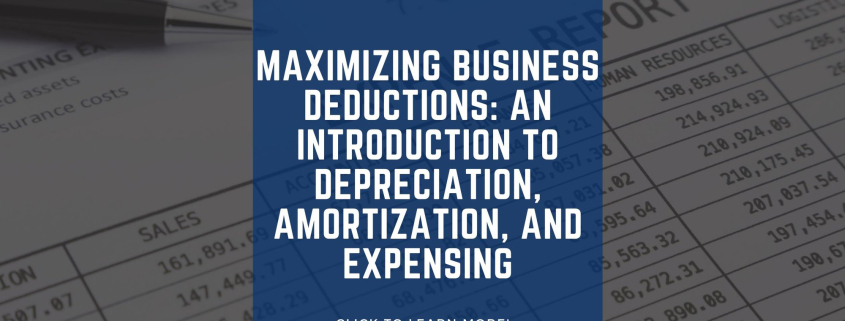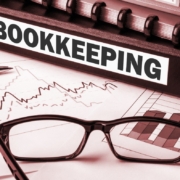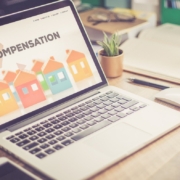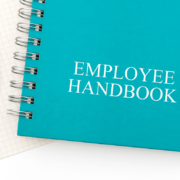Maximizing Business Deductions: An Introduction to Depreciation, Amortization, and Expensing
Article Highlights:
- MACRS Depreciation
- Bonus Depreciation
- Section 179 Expensing
- Amortization
- Materials and Supplies Expensing
- The De Minimis Safe Harbor Rule Expensing
- Routine Maintenance Expensing
- Per Building Safe Harbor for Small Taxpayers Expensing
In business accounting and taxation, strategic expense deductions significantly impact a company’s financial health and tax liabilities. Businesses of all sizes seek ways to optimize their financial strategies. One critical area is effectively using write-offs. Write-offs, or deductions, help businesses manage taxable income by accounting for everyday expenditures or asset depreciation. By properly deducting these expenses, businesses lower taxable income, reducing taxes and freeing up resources for investment.
In this article, we will delve into each of these deduction methods—depreciation, amortization, and expensing—exploring their nuances, benefits, and strategic applications. By gaining a comprehensive understanding of these key financial tools, businesses can make informed decisions that enhance their financial strength and positioning.

MACRS DEPRECIATION
Depreciation is a key accounting concept that allows businesses to allocate the cost of tangible assets over their useful life. In the United States, the Modified Accelerated Cost Recovery System (MACRS) is the prevailing method for calculating depreciation for tax purposes. This system offers a structured way to recover the cost of assets, ultimately reducing taxable income. Assets are grouped into different classes based on their expected useful life under MACRS. Each class has a predetermined recovery period and associated methods to calculate depreciation, allowing businesses to match the depreciation of assets with their usage and wear. Here are the most common classes of depreciable property.
5-Year Property
The 5-year class serves the purpose of enabling quicker recovery for items that may become technologically obsolete relatively quickly, and typically includes:
- Computers and Peripheral Equipment: Includes devices like servers and hardware required for business operations.
- Office Machinery: Copiers, printers, and similar equipment used exclusively within an office setup.
- Cars and Light Trucks: Vehicles used for business purposes.
7-Year Property
This class benefits from a moderately extended recovery period that reflects the durability and continued utility of such assets and is commonly associated with:
- Office Furniture and Fixtures: Desks, chairs, and other furnishings that provide lasting utility beyond immediate technological change.
- Agricultural Machinery: Equipment used on farms, such as tractors and harvesters.
27.5-Year Property
The 27.5-year period reflects the relatively longer economic life associated with residential rental properties, accounting for physical longevity and wear over time.
- Residential Rental Property: Buildings or structures where 80% or more of the gross rental income is from dwelling units.
39-Year Property
The 39-year recovery period reflects the expected lifespan of commercial structures, recognizing their physical permanence and long-term business utility.
- Non-residential Real Property: Commercial buildings and structures that house businesses, such as office buildings and warehouses.
Land
Excluded from both the 27.5- and 39-year real property depreciation periods is land. This is because land doesn’t wear out, become obsolete, or get used up over time. Therefore, you must reduce the real property’s cost basis by the land value when calculating the property’s depreciation.
BONUS DEPRECIATION
Bonus depreciation was originally introduced as part of the Job Creation and Worker Assistance Act of 2002. The provision allowed businesses to depreciate 30% of the cost of qualifying property in the first year, with normal depreciation rules applying to the remaining 70%. Over the years, it has been modified and extended multiple times, including the increase to 100% for a few years, and the current phaseout of the deduction (see table below).
Bonus depreciation allows businesses to take a significant first-year deduction on the purchase of eligible assets. It provides an immediate tax benefit by speeding up the depreciation process, thereby enhancing cash flow. This incentive is designed to stimulate investment and growth by making it more financially attractive for businesses to acquire new assets.
Application
Bonus depreciation applies to a broad range of tangible business property. This includes:
- New and Used Property: While the rule traditionally applied only to new property, changes in tax law now allow used property to qualify, as long as the taxpayer is the first to use it.
- Depreciable Personal Property: Includes machinery, equipment, computers, appliances, and furniture. (Here, “personal” is used to differentiate between real estate property.)
- Qualified Improvement Property: Enhancements to the interior of non-residential buildings, excluding enlargements, elevators/escalators, and internal structural framework.
It's important to note that some assets, such as buildings themselves, fall outside the scope of bonus depreciation.
Phase-Out Percentages
As of recent tax law updates, bonus depreciation is in a phase-out period. The percentages are slated to decline annually as follows:
- 2024: 60% bonus depreciation
- 2025: 40% bonus depreciation
- 2026: 20% bonus depreciation
- 2027 and beyond: 0% bonus depreciation
These decreasing percentages mean that businesses will gradually lose the immediate deduction benefits, impacting cash flow and investment strategies.
Possibility of Reinstatement
There is ongoing discussion in both political and business circles about the potential reinstatement of bonus depreciation to 100%. Some lawmakers and industry advocates argue that restoring full bonus depreciation could revitalize economic growth. The historical precedent demonstrates that Congress has reinstated tax incentives like these when deemed beneficial for economic conditions.
SECTION 179 EXPENSING
In business accounting and taxation, strategic expense deductions impact a company’s financial health and tax liabilities. Businesses seek ways to optimize financial strategies. One key area is effectively using write-offs. Write-offs, or deductions, help manage taxable income by accounting for everyday expenses or asset depreciation. Properly deducting these expenses lowers taxable income, reduces taxes, and frees up resources for investment.
Section 179 Limits
The Section 179 limits are annually adjusted for inflation. The deduction limit for 2025 is $1,250,000. This means that businesses can immediately expense up to $1,250,000 of the cost of qualifying property. The spending cap for the total amount of equipment purchased is $3,130,000. Once purchases exceed this cap, the deduction begins to phase out on a dollar-for-dollar basis until it phases out completely.
Qualifying Business Assets for Section 179
Section 179 covers a broad spectrum of tangible business assets. Qualifying assets typically include:
- Tangible Personal Property: Machinery, office furniture, equipment, and business vehicles with a gross weight over 6,000 pounds.
- Off-the-shelf Software: Software not custom-designed for the company, but available for a general market.
- Certain Improvements to Business Properties: These may include improvements to non-residential properties, like HVAC systems, alarm systems, and roofing.
However, some property types are not eligible for Section 179 expensing, such as most real estate properties, properties considered investment properties, or properties primarily used outside the United States.
Recapture Provisions
Businesses must be aware of the recapture provisions embedded within Section 179. These provisions come into play when the business use of the property falls to 50% or less during its recovery period. When this occurs, the business may need to recapture part or all of the Section 179 deduction as ordinary income, potentially increasing its taxable income for that year.
AMORTIZATION
Amortization is a key financial concept, especially relevant for businesses and investors who deal with various types of assets. Though like depreciation, it specifically pertains to intangible assets and certain types of expenses, offering a structured approach to cost recovery over time.
What is Amortization?
Amortization is the practice of gradually reducing the value of an intangible asset over a specified period. It involves spreading out a capital expenditure over a set timeframe, typically through periodic installments. The goal is to align the asset's cost with its useful life, thereby providing a clearer picture of financial health and profitability in accounting records.
Applications
Amortization primarily applies to:
- Intangible Assets: Intangible assets are non-physical assets that still hold significant value. Common examples include:
- Goodwill: The premium paid over the fair value during the acquisition of a company, representing non-physical advantages like brand reputation.
- Patents and Trademarks: Legal rights granted for inventions, or symbols and names that identify products or brands.
- Copyrights: Rights protecting the use of original works such as books, music, and software.
- Franchises: Licensing agreements allowing one to operate a business using a larger company's brand and business model.
- Licenses or Permits: Legal permissions to engage in specific activities that may involve regulated industries or specific market territories.
Taxpayers amortize the costs associated with these intangibles over their useful life, typically using a straight-line method that allocates equal amounts each year. The duration of this period aligns with legal, regulatory, or economic conditions affecting the asset.
Amortization vs. Depreciation
While both processes and concepts may seem similar, the key difference lies in the type of assets they relate to. Depreciation pertains to tangible assets like buildings, machinery, and equipment, whereas amortization deals with intangibles. Additionally, depreciation methods vary (such as declining balance), while amortization for intangible assets typically utilizes a straight-line approach.
EXPENSING OPTIONS IN THE CAP AND REPAIR REGULATIONS
Understanding the nuances of capitalization and repair regulations can significantly influence financial strategies and business decision-making. These regulations outline various expensing options, enabling businesses to manage expenses effectively while adhering to IRS standards. Here, we delve into four key expensing options: materials and supplies, the de minimis safe harbor rule, routine maintenance, and the per-building safe harbor for small taxpayers.
Materials and Supplies
The distinction between capitalizing and expensing materials and supplies is crucial for accurate financial reporting. Under IRS regulations, the IRS defines materials and supplies as tangible property items that the taxpayer uses or consumes in operations and that meet certain cost thresholds or usage parameters.
- Non-Incidental Materials and Supplies: Taxpayers generally track and deduct these items as expenses in the tax year they use or consume them. They include items with a useful life of 12 months or less, or items costing less than $200 per unit.
- Incidental Materials and Supplies: These are deducted in the year they are purchased. They typically include low-cost items for which keeping records is not administratively practical, like office supplies.
The De Minimis Safe Harbor Rule
The de minimis safe harbor is a practical and taxpayer-friendly election, allowing businesses to avoid capitalizing certain lower-cost acquisitions, thereby simplifying compliance and record-keeping.
- Election Criteria: Businesses can elect to expense items if they cost less than $2,500 per item or invoice ($5,000 if the business has an applicable financial statement such as audited financials).
- Application: This rule applies to materials and supplies, and other tangible properties. Businesses report these amounts as business expenses, providing a degree of flexibility in managing cash flow and expenses.
Routine Maintenance
Routine maintenance costs include expenses that taxpayers incur to keep property in efficient operating condition without materially increasing its value or lifespan. They help businesses sidestep the complexities of capitalization under certain circumstances.
- Definition: The IRS defines routine maintenance as activities that a taxpayer expects to perform more than once over the class life of an asset. These activities include inspections, cleaning, testing, and replacement of damaged or worn parts.
- Expensing Benefit: Taxpayers can deduct these expenses immediately because they do not materially improve the property's value or extend its life beyond original expectations.
Per Building Safe Harbor for Small Taxpayers
This provision offers relief, particularly for small business taxpayers, allowing them greater ease in managing repairs and improvements without the burden of capitalization where it might otherwise be required.
- Eligibility: To qualify, the average annual gross receipts of the taxpayer must be $10 million or less in the preceding three tax years. Furthermore, the taxpayer must own the building or lease it and the building’s unadjusted basis cannot exceed $1 million.
- Application: Small taxpayers can elect to deduct repair and improvement costs, provided they do not exceed the lesser of 2% of the unadjusted basis of the building or $10,000 per building.
The landscape of asset depreciation and expense deductions offers a wealth of options for businesses aiming to optimize their tax outcomes. Each method, from depreciation to available expensing options, brings its own advantages and complexities, and navigating these choices can be challenging. This firm understands the intricacies involved and stands ready to help you make the most informed decisions for your business.
Visit us today at www.fiducial.com/consultations to talk with our experts.









